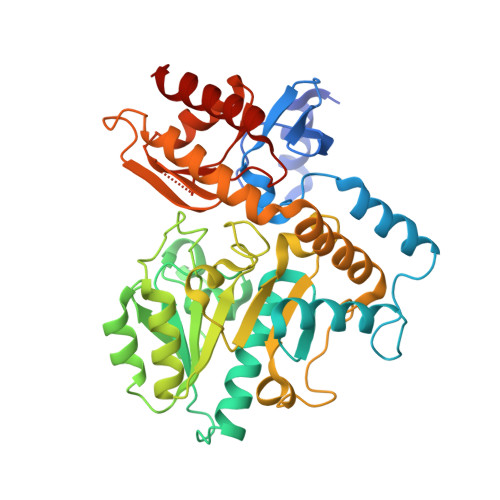R180T variant of delta-ornithine aminotransferase associated with gyrate atrophy: biochemical, computational, X-ray and NMR studies provide insight into its catalytic features.
Montioli, R., Paiardini, A., Giardina, G., Zanzoni, S., Cutruzzola, F., Cellini, B., Borri Voltattorni, C.(2019) FEBS J 286: 2787-2798
- PubMed: 30957963
- DOI: https://doi.org/10.1111/febs.14843
- Primary Citation of Related Structures:
6HX7 - PubMed Abstract:
Among the over 50 gyrate atrophy-causing mutations of ornithine δ-aminotransferase (OAT), the R180T involves an active site residue located at the dimer interface, which in the crystal structure of OAT complexed with 5-fluoromethylornithine engages a salt bridge with the α-carboxylate of the substrate analogue. Starting from the previous finding that no transaminase activity was detected in CHO-K 1 cells expressing the R180T variant, here we try to shed light at the protein level on the structural and/or functional defects of the R180T variant. To this aim, the variant has been cloned, expressed, purified and characterized by a combination of biochemical and structural studies. Although the R180T variant shares a similar overall conformation with the wild-type, its crystal structure solved at 1.8 Ǻ reveals slight structural alterations at the active site and at the dimeric interface. These changes are consistent with the spectroscopic and kinetic results, indicating that the variant, as compared with the wild-type OAT, shows (a) an increased K m value for l-ornithine (l-Orn), (b) an altered pyridoxal 5'-phosphate binding mode and affinity and (c) an increased thermostability. In addition, the R180T mutant exhibits a remarkable loss of catalytic activity and is endowed with the ability to catalyse not only the δ-transamination but also, albeit to a lesser extent, the α-transamination of l-Orn. Overall, these data indicate that the slight structural changes caused by the R180T mutation, preventing a proper collocation of l-Orn at the active site of OAT, are responsible for the notable reduction of the catalytic efficiency. ENZYMES: Ornithine aminotransferase EC 2.6.1.13. DATABASES: 6HX7.pdb.
Organizational Affiliation:
Department of Neurosciences, Biomedicine and Movement Sciences, University of Verona, Italy.















